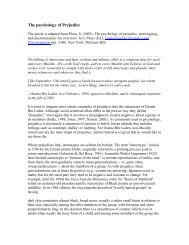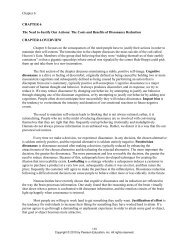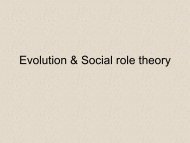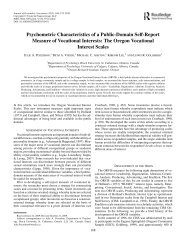Attitudes and Attitude Change CHAPTER 7 Attitudes and Attitude ...
Attitudes and Attitude Change CHAPTER 7 Attitudes and Attitude ...
Attitudes and Attitude Change CHAPTER 7 Attitudes and Attitude ...
You also want an ePaper? Increase the reach of your titles
YUMPU automatically turns print PDFs into web optimized ePapers that Google loves.
194<br />
Copyright © 2010 by Pearson Education, inc. All rights reserved.<br />
<strong><strong>Attitude</strong>s</strong> <strong>and</strong> <strong>Attitude</strong> <strong>Change</strong><br />
3. People’s attitudes toward greeting cards are clearly affectively based. Your approach should<br />
therefore be to play on these emotions. You would recommend presenting ads that depict joyous<br />
birthdays <strong>and</strong> weddings, proud moments like graduation, etc. (pp. 179 & 200)<br />
4. According to the Elaboration Likelihood Model, people take the central route to persuasion when<br />
they are both motivated <strong>and</strong> able to attend to arguments presented. Subsequent attitude change<br />
will persist, be consistent with behaviors, <strong>and</strong> resist counterpersuasion. If people are either<br />
unmotivated or unable to attend to the arguments, they will attend to cues, which are peripheral to<br />
the message, <strong>and</strong> take the peripheral route to persuasion. Subsequent attitude change will be<br />
short-lived, be inconsistent with behaviors, <strong>and</strong> will change again in the face of<br />
counterpersuasion.<br />
(pp. 185-189)<br />
5. <strong>Attitude</strong> inoculation makes people immune to attempts to change cognitively based attitudes by<br />
initially exposing them to small doses of the arguments against their position. Peer pressure is<br />
likely to play on adolescents’ feelings of autonomy <strong>and</strong> social rejection. That is, it is directed at<br />
changing affectively, rather than cognitively based attitudes. The attitude inoculation technique<br />
can be modified by exposing adolescents to small doses of peer pressure during role-playing<br />
interventions. (pp. 194-196)<br />
6. Counterattitudinal advocacy can lead to private attitude change when the person does not have<br />
sufficient external justification for their behavior. Cognitive dissonance is the process underlying<br />
this change. (pp. 183-184)<br />
7. Peripheral cues are surface characteristics of the message such as the length of the message, who<br />
delivers the message (e.g. expert, celebrity), or the attractiveness of the communicator. The<br />
central route to persuasion leads to lasting attitude change. (pp. 186 & 189)<br />
8. A moderate level of fear is best. The moderate amount of fear should be combined with a<br />
message that will teach people how to reduce the fear because then the audience will be<br />
motivated to analyze the message carefully <strong>and</strong> will likely change their attitudes via the central<br />
route. (pp. 190-191)<br />
9. <strong><strong>Attitude</strong>s</strong> predict spontaneous behaviors only when they are highly accessible to people. <strong><strong>Attitude</strong>s</strong><br />
can predict deliberate behaviors when you know about the person’s intentions. According to the<br />
theory of planned behavior, intention is determined by three things: the person’s attitude toward<br />
the specific behavior, the person’s subjective norms, <strong>and</strong> the person’s perceived behavioral<br />
control. (pp. 197-199)<br />
10. Many studies of subliminal perception have been conducted <strong>and</strong> there is no evidence that the<br />
types of subliminal messages encountered in everyday life have any influence on people’s<br />
behavior. There is evidence for subliminal effects in carefully controlled laboratory studies.<br />
However, to get subliminal effects, researchers have to make sure that the illumination of the<br />
room is just right, that people are seated just the right distance from a viewing screen, <strong>and</strong> that<br />
nothing else is occurring to distract them as the subliminal stimuli are flashed. These messages<br />
might have subtle influences on people’s liking for an ambiguous stimulus, but they cannot<br />
override their wishes <strong>and</strong> desires.<br />
(pp. 203-204)

















